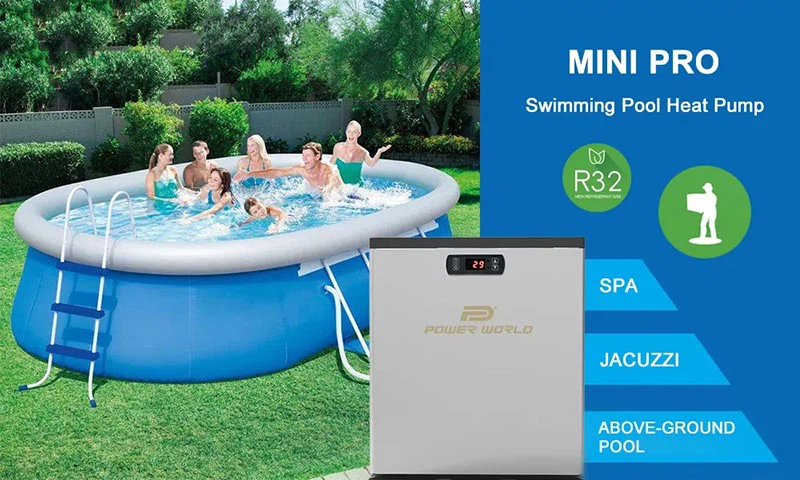How Long Does It Take To Heat A Pool With A Heat Pump? 7 Proven Factors & Expert Tips To Speed It Up

7 Key Factors That Determine How Long to Heat a Pool
1. Heat Pump Size vs. Pool Volume
The BTU (British Thermal Unit) capacity of your heat pump must align with your pool’s size. For example:
A 20,000-gallon pool requires a 140,000–160,000 BTU heat pump to raise the temperature by 1–2°F per hour.
An undersized unit (e.g., 100,000 BTU for a 30,000-gallon pool) may take 30–50% longer to heat, increasing energy bills.
Pro Tip: Use Power World’s Pool Heating Calculator to match your pool’s volume with the ideal BTU range.
2. Ambient Temperature & Climate
Heat pumps rely on air warmth to operate efficiently. Colder climates slow heating significantly:
At 50°F (10°C): A standard heat pump heats a 15,000-gallon pool by 0.5–1°F per hour.
At 80°F (27°C): The same system can achieve 2–3°F per hour.
Solution: Opt for low-temperature heat pumps like Power World’s Arctic Pro Series, designed to maintain a COP of 4.0 even at 14°F (-10°C).
3. Pool Covers & Insulation
An uncovered pool loses 70–80% of its heat to evaporation and wind. A high-quality thermal cover can:
Reduce heating time by 25–40% (e.g., from 48 hours to 30 hours for a 20°F temperature rise).
Save 200–500 annually on energy costs.
Case Study: A Florida resort reduced its pool heating time by 35% after installing solar covers with Power World’s EcoSilent 140K BTU heat pump.
4. Desired Temperature Increase
The larger the temperature gap, the longer it takes:
Small Rise (5–10°F): Takes 8–12 hours for a 20,000-gallon pool.
Large Rise (15–20°F): Requires 24–72 hours, depending on the heat pump’s efficiency.
Example: Heating a 15,000-gallon pool from 60°F to 85°F with a 120,000 BTU heat pump takes 2–3 days in mild climates.
5. Heat Pump Efficiency (COP Rating)
The Coefficient of Performance (COP) measures energy efficiency. Higher COP = faster heating:
COP 5.0: 5x more efficient than electric heaters.
COP 12.0+: Power World’s Quiet Pro Series achieves this, cutting heating time by 50% compared to COP 6.0 models.
Cost Impact: A COP 12.0 heat pump reduces annual energy costs by 600–900 vs. gas heaters.
6. Water Circulation & Filtration
Poor circulation creates “cold spots” and prolongs heating:
Run the pool pump 8–12 hours daily during heating.
Clean filters monthly-clogged filters add 1–3 hours to heating time.
Smart Solution: Pair your heat pump with a variable-speed pump to optimize flow rates and save energy.
7. Solar Integration & Hybrid Systems
Combining a heat pump with solar panels can:
Heat pools 2x faster on sunny days.
Reduce annual heating costs by 50–70%.
Real-World Example: A California homeowner cut heating time from 48 to 20 hours by integrating Power World’s SolarBoost Hybrid System.

How to Heat a Swimming Pool Faster: 5 Expert Tips
Pre-Heat Strategically
Start heating 24–48 hours before use, especially in colder weather.
Use a Dark-Colored Solar Cover
Dark covers absorb sunlight, adding 2–4°F daily for free.
Upgrade to a High-BTU Heat Pump
Power World’s 160,000 BTU Titan Series heats a 30,000-gallon pool in 10–15 hours-30% faster than standard models.
Insulate Plumbing Lines
Prevent heat loss in pipes with foam sleeves, saving 5–10% of energy.
Optimize Pump Schedules
Run the pump during the hottest part of the day (10 AM–4 PM) to maximize heat absorption.

Why Heat Pumps Outperform Gas & Solar Heaters
Cost Efficiency
Heat pumps use 75–80% less energy than electric heaters and 50% less than gas models.
A COP 12.0 heat pump costs
300–500/year to operate vs.1,200–1,800 for gas heaters.
Speed & Reliability
Heat pumps work 2x faster than solar panels in cloudy weather.
Power World’s Arctic Pro Series delivers consistent heat even in sub-freezing temperatures.
Longevity & Eco-Friendliness
Titanium heat exchangers last 15–20 years vs. 5–8 years for gas heaters.
Zero direct CO2 emissions align with global sustainability goals.
FAQs: How Long to Heat a Pool?
Q: How long does it take a pool to heat up in winter?
A: With a low-temperature heat pump, expect 2–4 days to raise a 20,000-gallon pool by 15°F in 40°F weather.
Q: How to heat a swimming pool fast on a budget?
A: Combine a high-COP heat pump (e.g., Power World’s EcoSilent Series) with a solar cover and strategic pre-heating.
Q: Does pool shape affect heating time?
A: Yes! Freeform pools with uneven depths may take 10–15% longer to heat than rectangular pools due to circulation challenges.
Final Tip: Size Matters
Always choose a heat pump 20–30% more powerful than your calculated needs to account for climate fluctuations and faster heating.

